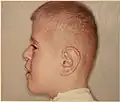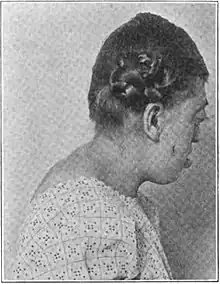Brachycephaly
Brachycephaly (derived from the Ancient Greek βραχύς, 'short' and κεφαλή, 'head') is the shape of a skull shorter than average in its species. It is perceived as a desirable trait in some domesticated dog and cat breeds, notably the pug and Persian, and can be normal or abnormal in other animal species.
| Brachycephaly | |
|---|---|
| Other names | Brachyceplalic |
 | |
| Brachycephaly and dolichocephaly | |
| Specialty | Medical genetics |
In humans, is can appear both pathologically and non-pathologically as a result of normal human variation. It is particularly common in Mongolians and the Andamanese.[1]
In anthropology, human populations have been characterized as either dolichocephalic (long-headed), mesocephalic (moderate-headed), or brachycephalic (short-headed). The usefulness of the cephalic index was questioned by Giuseppe Sergi, who argued that cranial morphology provided a better means to model racial ancestry.[2]
When pathological, it is known as flat head syndrome, and it results from premature fusion of the coronal sutures, or from external deformation. The coronal suture is the fibrous joint that unites the frontal bone with the two parietal bones of the skull. The parietal bones form the top and sides of the skull. This feature can also be a symptom of Down syndrome.
There are also cases of brachycephaly associated with plagiocephaly. Brachycephaly with plagiocephaly is positional and has become more prevalent since the "Back to Sleep" campaign. The Back to Sleep campaign began in 1994 as a way to educate parents about ways to reduce the risk for sudden infant death syndrome (SIDS). The campaign was named for its recommendation to place healthy babies on their backs to sleep. Placing babies on their backs to sleep reduces the risk for SIDS, also known as "cot death" or "crib death." This campaign has been successful in promoting infant back sleeping and other risk-reduction strategies to parents, family members, child care providers, health professionals, and all other caregivers of infants, at a cost of increasing the incidence of this deformation of the head.[3] It is considered a cosmetic problem.[4][5] Many pediatricians remain unaware of the issue and possible treatments. Treatments include regular prone repositioning of babies ("tummy time").[6]
Brachycephaly as a desired trait
Brachycephaly also describes a developmentally normal type of skull with a high cephalic index, such as in snub-nosed breeds of dog such as pugs, Shih Tzus, and bulldogs or cats such as the Persian, Exotic and Himalayan. The term is from Greek roots meaning 'short' and 'head'.[7] While being a desirable trait of specific cat and dog breeds, the production and breeding of brachycephalic animals is technically considered as an animal abuse in some legislations. This arises from the fact that animals with significantly shortened skulls frequently develop brachycephalic airway obstructive syndrome, causing them to have difficulties when breathing, suffering from hyperthermia due to insufficient cooling abilities and frequent infections of the cornea and lacrimal glands. Breeding of animals that will have significantly worsened life quality due to anatomical abnormalities is clearly stated to be illegal in some European countries, yet the production of such breeds is still very frequent. Apart from these, brachycephalic pups and kittens also have high prenatal mortality. Attention should be paid to breed standards which promote increased brachycephaly in cats which has the potential to negatively impact their welfare, and potential buyers of brachycephalic cat breeds should be made aware of the risks of their conformation.[8]
Diagnosis
Conditions with brachycephaly
- Achard syndrome
- Achondrogenesis type II
- Acrocephalosyndactyly type I
- Acrodysostosis 1 with or without hormone resistance
- Acrofrontofacionasal dysostosis
- Acromelic frontonasal dysostosis
- Acyl-CoA oxidase deficiency
- Adenylosuccinate lyase deficiency
- Agenesis of the corpus callosum with peripheral neuropathy
- ALDH18A1-related de Barsy syndrome
- ALG9 congenital disorder of glycosylation
- Alveolar capillary dysplasia with pulmonary venous misalignment
- Angelman syndrome
- Antley-Bixler syndrome
- Aspartylglucosaminuria
- Autism spectrum disorder due to AUTS2 deficiency
- Autosomal recessive faciodigitogenital syndrome
- Axenfeld-Rieger anomaly
- Bailey-Bloch congenital myopathy
- Bardet-Biedl syndrome
- CHIME syndrome
- Cleidocranial dysplasia, recessive form
- Coffin-Siris syndrome
- Complete trisomy 21 syndrome
- Complex lethal osteochondrodysplasia
- Congenital contractural arachnodactyly
- Congenital disorder of glycosylation, type iit
- Congenital heart defects and ectodermal dysplasia
- Cornelia de Lange syndrome
- Craniofacial dysplasia-osteopenia syndrome
- Craniofrontonasal syndrome
- Craniosynostosis-anal anomalies-porokeratosis syndrome
- Crouzon syndrome
- Crouzon syndrome-acanthosis nigricans syndrome
- DeSanto-Shinawi syndrome due to WAC point mutation
- Ehlers-Danlos syndrome
- Fine-Lubinsky syndrome
- Fontaine progeroid syndrome
- Frank-Ter Haar syndrome
- Frontonasal dysplasia-severe microphthalmia-severe facial clefting syndrome
- Frontonasal dysplasia with alopecia and genital anomaly
- Gomez-Lopez-Hernandez syndrome
- Hallermann-Streiff syndrome
- Hereditary spastic paraplegia
- Hirsutism-skeletal dysplasia-intellectual disability syndrome
- Holoprosencephaly, recurrent infections, and monocytosis
- Hypotonia, infantile, with psychomotor retardation and characteristic facies
- Intellectual disability-facial dysmorphism syndrome due to SETD5 haploinsufficiency
- Intellectual disability-microcephaly-strabismus-behavioral abnormalities syndrome
- KBG syndrome
- Kleefstra syndrome
- Kohlschutter-Tonz syndrome-like
- Larsen-like syndrome, B3GAT3 type
- Lethal occipital encephalocele-skeletal dysplasia syndrome
- Lethal osteosclerotic bone dysplasia
- Mandibuloacral dysplasia progeroid syndrome
- MEGF8-related Carpenter syndrome
- Methylmalonic acidemia with homocystinuria, type cblX
- MGAT2-congenital disorder of glycosylation
- Microbrachycephaly-ptosis-cleft lip syndrome
- Microcephaly, facial dysmorphism, renal agenesis, and ambiguous genitalia syndrome
- Microphthalmia with brain and digit anomalies
- MOMO syndrome
- Muenke syndrome
- Neonatal pseudo-hydrocephalic progeroid syndrome
- Oculodentodigital dysplasia, autosomal recessive
- Osteogenesis imperfecta
- Osteosclerosis, Stanescu type
- Phosphoribosylaminoimidazole carboxylase deficiency
- Pontocerebellar hypoplasia
- Potocki-Shaffer syndrome
- RAB23-related Carpenter syndrome
- Radial aplasia-thrombocytopenia syndrome
- Renpenning syndrome
- Ritscher-Schinzel syndrome
- Saethre-Chotzen syndrome
- Smith-Magenis syndrome
- Spastic paraplegia, intellectual disability, nystagmus, and obesity
- Spondyloepimetaphyseal dysplasia, Genevieve type
- SRD5A3-congenital disorder of glycosylation
- Trigonocephaly-bifid nose-acral anomalies syndrome
- Weill-Marchesani syndrome
 Apert syndrome
Apert syndrome Carpenter syndrome
Carpenter syndrome.jpg.webp) Microcephaly
Microcephaly Pfeiffer syndrome
Pfeiffer syndrome Saethre-Chotzen syndrome
Saethre-Chotzen syndrome
Treatment
Brachycephaly can be corrected with a cranial remolding orthoses (helmet) which provide painless total contact over the prominent areas of the skull and leave voids over the flattened areas to provide a pathway for more symmetrical skull growth. Treatment generally takes 3–4 months, but varies depending on the infant's age and severity of the cranial asymmetry.
However, studies by scientists in the Netherlands investigating helmet therapy on mild to moderate cases of brachycephaly have found there was no significant difference over time between infants treated with helmets and infants left untreated. All parents of infants treated with helmets confirmed negative side effects including skin irritation and sweating.[10][11] The study was criticised by the American Orthotic & Prosthetic Association in a letter to the New York Times. The letter noted that the study focused only on mild to moderate cases, saying that helmet treatment may still be useful for more severe cases. The letter also criticised the low participation rate (21%) of the randomized study, and noted that the incidence of fitting issues in the study, at 73%, "seems very high".[12]
See also
References
- "Cephalic index | skull shape, head shape, cranial index | Britannica". www.britannica.com. Retrieved 19 September 2023.
- K. Killgrove (2005). "Bioarchaeology in the Roman World" (PDF). M.A. Thesis, UNC Chapel Hill. Archived from the original (PDF) on 28 March 2012.
{{cite journal}}: Cite journal requires|journal=(help) - John Persing; et al. (1 July 2003). "Prevention and Management of Positional Skull Deformities in Infants". Pediatrics. 112 (1): 199–202. doi:10.1542/peds.112.1.199. PMID 12837890.
- "Plagiocephaly and brachycephaly (flat head syndrome)". NHS. 13 February 2012.
- Matthew L. Speltz; et al. (15 February 2010). "Case-Control Study of Neurodevelopment in Deformational Plagiocephaly". Pediatrics. 125 (3): e537–e542. doi:10.1542/peds.2009-0052. PMC 3392083. PMID 20156894.
Although DP is considered a purely aesthetic problem by many practitioners, several studies have challenged this view.
- Di Rocco, Federico; Ble, Valeria; Beuriat, Pierre-Aurelien; Szathmari, Alexandru; Lohkamp, Laura Nanna; Mottolese, Carmine (30 April 2019). "Prevalence and severity of positional plagiocephaly in children and adolescents". Acta Neurochirurgica. 161 (6): 1095–1098. doi:10.1007/s00701-019-03924-2. PMID 31041593. S2CID 141503557.
- Chisholm, Hugh, ed. (1911). . Encyclopædia Britannica (11th ed.). Cambridge University Press.
- Farnworth, Mark J et al. "Flat Feline Faces: Is Brachycephaly Associated with Respiratory Abnormalities in the Domestic Cat (Felis catus)?." PLOS ONE vol. 11,8 e0161777. 30 Aug. 2016, doi:10.1371/journal.pone.0161777
- "Brachycephaly (Concept Id: C0221356) - MedGen - NCBI". www.ncbi.nlm.nih.gov. Retrieved 7 April 2023.
- "Baby helmets 'have no added value', study finds". BBC News. 2 May 2014.
- Van Wijk, R. M.; Van Vlimmeren, L. A.; Groothuis-Oudshoorn, C. G. M.; Van Der Ploeg, C. P. B.; Ijzerman, M. J.; Boere-Boonekamp, M. M. (1 May 2014). "Helmet therapy in infants with positional skull deformation: randomised controlled trial". BMJ. British Medical Journal. 348: g2741. doi:10.1136/bmj.g2741. PMC 4006966. PMID 24784879.
- "AOPA Response to British Medical Journal Study" (PDF).
External links
- NINDS – Cephalic Disorders Overview Archived 4 October 2018 at the Wayback Machine
- Brachycephalic Official Website